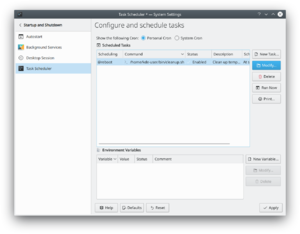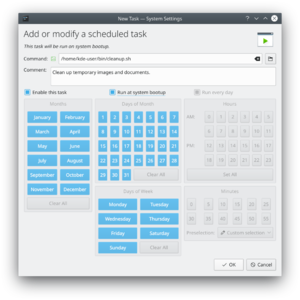System Settings/Task Scheduler: Difference between revisions
m (Better modules to translate) |
(Marked this version for translation) |
||
| Line 19: | Line 19: | ||
==== Adding and Modifying tasks ==== <!--T:11--> | ==== Adding and Modifying tasks ==== <!--T:11--> | ||
<!--T:12--> | |||
* Click "New Task..." to add a new task, or "Modify" to modify an existing task. The '''Add or modify existing task''' page will be displayed. | * Click "New Task..." to add a new task, or "Modify" to modify an existing task. The '''Add or modify existing task''' page will be displayed. | ||
<!--T:13--> | |||
[[Image:kcron-task-dialog.png|thumb|300px|center|The "Add or modify task" page of SystemSettings]] | [[Image:kcron-task-dialog.png|thumb|300px|center|The "Add or modify task" page of SystemSettings]] | ||
<!--T:14--> | |||
* Enter the command to be run. Click the folder icon to choose it from a dialog. | * Enter the command to be run. Click the folder icon to choose it from a dialog. | ||
<!--T:15--> | |||
* Enter a comment (optional). This should be descriptive, explaining what the task will do as the command may not always be obvious. | * Enter a comment (optional). This should be descriptive, explaining what the task will do as the command may not always be obvious. | ||
<!--T:16--> | |||
* Click '''Enable this task''' to enable the task to run. | * Click '''Enable this task''' to enable the task to run. | ||
<!--T:17--> | |||
* Click '''Run at system bootup''' to enable the script to run each time the system is booted. | * Click '''Run at system bootup''' to enable the script to run each time the system is booted. | ||
<!--T:18--> | |||
* Click '''Run every day''' to enable the script to run every day. This will automatically select the appropriate options. | * Click '''Run every day''' to enable the script to run every day. This will automatically select the appropriate options. | ||
<!--T:19--> | |||
* Using the buttons, choose when the command should be run. Not all parameters are required, those not needed may be left blank. | * Using the buttons, choose when the command should be run. Not all parameters are required, those not needed may be left blank. | ||
** Hours and Minutes are the time of day to run the task, not an interval. | ** Hours and Minutes are the time of day to run the task, not an interval. | ||
<!--T:20--> | |||
* When done, click <menuchoice>OK</menuchoice>. The task will be added and scheduled if enabled. | * When done, click <menuchoice>OK</menuchoice>. The task will be added and scheduled if enabled. | ||
Revision as of 09:14, 25 December 2018
General Information

Usage
Task Scheduler can be started by starting the System Settings application, and selecting . New tasks can be added and existing tasks edited or removed.
Adding and Modifying tasks
- Click "New Task..." to add a new task, or "Modify" to modify an existing task. The Add or modify existing task page will be displayed.

- Enter the command to be run. Click the folder icon to choose it from a dialog.
- Enter a comment (optional). This should be descriptive, explaining what the task will do as the command may not always be obvious.
- Click Enable this task to enable the task to run.
- Click Run at system bootup to enable the script to run each time the system is booted.
- Click Run every day to enable the script to run every day. This will automatically select the appropriate options.
- Using the buttons, choose when the command should be run. Not all parameters are required, those not needed may be left blank.
- Hours and Minutes are the time of day to run the task, not an interval.
- When done, click . The task will be added and scheduled if enabled.
Hints
- All the files that are modified are located in the /etc/cron directory where there are numerous files to look at.
- The command-line tool that allows you to have a look at the currently installed cron-jobs is
crontab -l
(that's the letter L).
